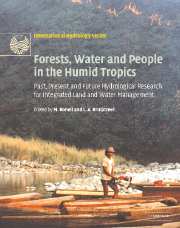 Forests, Water and People in the Humid Tropics
Forests, Water and People in the Humid Tropics Book contents
- Frontmatter
- Contents
- List of contributors
- Foreword
- Preface
- Acknowledgements
- Symposium and Workshop
- Introduction
- Part I Current trends and perspectives on people–land use–water issues
- 1 Trends and patterns of tropical land use change
- 2 The myth of efficiency through market economics: a biophysical analysis of tropical economies, especially with respect to energy, forests and water
- 3 Impacts of land cover change in the Brazilian Amazon: a resource manager's perspective
- 4 Forest people and changing tropical forestland use in tropical Asia
- 5 People in tropical forests: problem or solution?
- 6 Useful myths and intractable truths: the politics of the link between forests and water in Central America
- 7 Land use, hydrological function and economic valuation
- 8 Water resources management policy responses to land cover change in South East Asian river basins
- 9 Community-based hydrological and water quality assessments in Mindanao, Philippines
- Part II Hydrological processes in undisturbed forests
- Part III Forest disturbance, conversion and recovery
- Part IV New methods for evaluating effects of land-use change
- Part V Critical appraisals of best management practices
- Conclusion: Forests, water and people in the humid tropics: an emerging view
- Plate section
- References
6 - Useful myths and intractable truths: the politics of the link between forests and water in Central America
from Part I - Current trends and perspectives on people–land use–water issues
Published online by Cambridge University Press: 12 January 2010
- Frontmatter
- Contents
- List of contributors
- Foreword
- Preface
- Acknowledgements
- Symposium and Workshop
- Introduction
- Part I Current trends and perspectives on people–land use–water issues
- 1 Trends and patterns of tropical land use change
- 2 The myth of efficiency through market economics: a biophysical analysis of tropical economies, especially with respect to energy, forests and water
- 3 Impacts of land cover change in the Brazilian Amazon: a resource manager's perspective
- 4 Forest people and changing tropical forestland use in tropical Asia
- 5 People in tropical forests: problem or solution?
- 6 Useful myths and intractable truths: the politics of the link between forests and water in Central America
- 7 Land use, hydrological function and economic valuation
- 8 Water resources management policy responses to land cover change in South East Asian river basins
- 9 Community-based hydrological and water quality assessments in Mindanao, Philippines
- Part II Hydrological processes in undisturbed forests
- Part III Forest disturbance, conversion and recovery
- Part IV New methods for evaluating effects of land-use change
- Part V Critical appraisals of best management practices
- Conclusion: Forests, water and people in the humid tropics: an emerging view
- Plate section
- References
Summary
INTRODUCTION
In the final days of October 1998, Hurricane Mitch unleashed an apocalyptic rampage of floods and mudslides that wreaked havoc on Honduras, Nicaragua, Guatemala and El Salvador, causing 9000 deaths and US$6 billion in damage (Smyle, 1999; see also Bonell, Callaghan, and Connor, this volume). Once the floods subsided, people throughout the region began asking why the storm had sown such great destruction and how they could prevent future catastrophes. Press reports, public officials, environmentalists and international agencies claimed deforestation had greatly magnified the damage. To make the region less vulnerable to disasters they proposed greater support for reforestation, soil conservation and civil defence. ‘Watershed management’ and ‘vulnerability’ became watchwords. The agencies practically fell over one another to see who could invent more initiatives with those words in their titles.
Hurricane Mitch put watershed (river basin and/or catchment) degradation firmly on the Central American political landscape. Nevertheless, public concern about the problem had been growing steadily since the 1970s. News stories and consultant reports claiming that sediment was clogging up the region's dams, rivers and coasts had caused consternation in policy circles. Non-governmental organisations (NGOs), the media and others had convinced much of the public that deforestation had exacerbated seasonal water shortages by increasing surface runoff and reducing rainfall. Many agencies had set up reforestation, soil conservation and protected area projects in response to these concerns.
Recent interest in payments for environmental services has further fueled enthusiasm for catchment management.
- Type
- Chapter
- Information
- Forests, Water and People in the Humid TropicsPast, Present and Future Hydrological Research for Integrated Land and Water Management, pp. 86 - 98Publisher: Cambridge University PressPrint publication year: 2005
References
- 13
- Cited by


